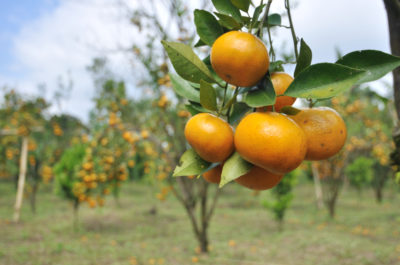The prospect of getting a daily shot of GMO foods in the morning with a glass of “all natural” orange juice may not be something you are looking forward to. Nevertheless, it is closer to reality than you may expect and it may take less than five years for the genetically modified orange trees to bear fruit.
Efforts are already under way to desensitize the public and to prepare the ground for better reception of the genetically altered drink. The article that appeared in The New York Times this July is just one of them. It attempts to make us believe that GMO orange is the only way left to save the orange trees, and that Ricke Kress, president of the orange producing firm Southern Gardens Citrus, who ordered the bitter pill, is a philanthropist with noble intentions.
The issue in focus is the citrus greening disease, otherwise known as Huanglongbing, or HLB for short, caused by the bacterium Candidatus liberibacter. It is spread by a tiny flying insect called Asian citrus psyllid that attacks the young leaves of plants belonging to the citrus family. Thousands of acres of citrus plantations across Florida are at risk, including the two and a half million trees of the Southern Gardens. Since almost all the trees come from the same rootstock, all are equally susceptible to the disease. Efforts to find naturally resistant varieties of citrus trees had been futile so far. However, projecting genetic manipulation as the only solution is nothing but an attempt to hoodwink the public.
When the mad cow disease wreaked havoc in the meat industry of Europe in 2009, about 4.4 million cattle were slaughtered to contain it. When the finger of suspicion pointed to the practice of feeding naturally herbivorous cattle with meat and bone meal prepared from the carcasses and remains of cattle, there might have been two options: either to stop that unnatural practice, or to develop a meat-eating cow by genetic engineering!
Warning Signs That Triggered The Deadliest Famines In History…
Unlike viral infections, bacterial diseases in oranges can be controlled to some extent by specific antibiotics. Moreover, the disease-spreading psyllid fly can be controlled biologically and chemically. A wasp used in Florida to control the fly has been found to be effective, too. Experiments in this direction can be costly, but definitely a better alternative to tampering with nature.
Haven’t we always been tampering with nature?
Selective breeding and hybridization are human attempts to control nature. But tampering with the genetic make-up of organisms is like opening the Pandora’s Box, especially since the long-term effects of our actions may not be evident immediately. By introducing a foreign gene into an organism, we can switch on the production of certain proteins, but we cannot determine how they will interact with other cell metabolites of that particular organism.
The origin of HLB is traced to China, and it dates back to the early 20th century. But surprisingly, China has managed to keep their citrus industry alive and thriving, so much so that they are poised to be the world leader in orange juice production within the next the years.
“In some places in China they essentially went to a scorched-earth policy and then came back in and replanted with healthy materials and implemented area-wide pest control strategies”, Fred Gmitter, a breeder and geneticist from the University of Florida, said.
But, the crux of the matter is that genetic engineering is big business. The company holding the patent for the GMO can make a huge profit, not only by selling the new stock, but by charging a royalty on the produce, too. According to Professor Erik Mirkov, who is working on the project of Southern Gardens in Texas A&M’s Agrilife Research Center, “These commonly include an upfront fee of $2 per tree, and a modest royalty fee on fruit yield.” They can eventually control the entire citrus production by getting every producer to change over to GMO orange cultivation. Some initial public resistance to the product is expected, but they are counting on gradual acceptance for want of an alternative.
It is common knowledge that diseases of all kinds have a free run when plants or animals – even people, for that matter- are concentrated in an area. Monoculture has not only reduced biodiversity, but has encouraged virulent forms of disease-causing agents to develop and proliferate. The need of the hour is a multi-pronged strategy to combat the immediate problem of citrus greening disease while taking concrete steps to save food production from the clutches of industrial giants. It is quite obvious that a more natural and sustainable approach to agriculture with polyculture should be our long-term goal.
The citrus-growing area has been reduced to nearly half of the original 900,000 acres in the 1960s. It is sad that many jobs have been lost. But the situation is not anywhere nearly as bad as the Potato Famine that gripped Ireland in 1845. Jobs can be created if this crisis is taken as a golden opportunity to turn around the agricultural scene. The soil and climate of the citrus-growing areas can be good enough for many other food crops. But the resistance of the industrial giants is the big hurdle. They’d rather play with public health than consider alternatives that may undermine their profit margins.
Genetic engineering is not the panacea of all ills as it is made out to be. For example, the citrus-greening disease is just one of the many diseases that threaten the orange trees. Many fungal and viral diseases also plague these high-intensity plantations. If the natural genetic make-up of the orange trees is overhauled gene by gene, in order to combat all these diseases, will it be worth consuming what is left over?
 Off The Grid News Better Ideas For Off The Grid Living
Off The Grid News Better Ideas For Off The Grid Living





